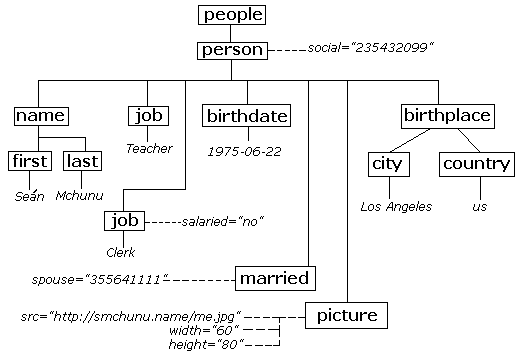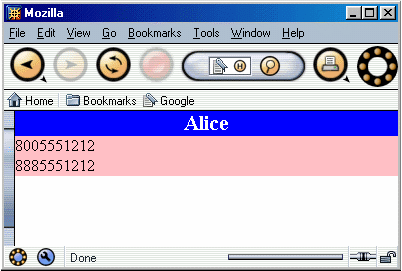XML
What is XML?
eXtensible Markup Language
XML is a meta markup language, meaning it tells you what form the markup takes, not what markup is allowed.
“Specific” markup languages are called applications of XML, perhaps things like:
- Chemical Markup Language
- Election Markup Language
- Ballot Markup Language
- Petri Net Markup Language
- Structured Graph Format
- Synchronized Multimedia Integration Language
- Controlled Trade Markup Language
XML was designed to be:
- Usable for Internet content (since SGML wasn’t very good, so they said)
- Supportive of a wide variety of applications
- Easy to process with a computer
- Human readable, not terse
- Simple
- Almost completely lacking in “optional” features.
The official specification is at: http://www.w3.org/TR/REC-xml. There is a nice annotated version of an older spec at http://www.xml.com/axml/testaxml.htm.
An Example XML Document
<people>
<person social="235432099">
<name>
<first>Seán</first>
<last>Mchunu</last>
</name>
<job>Teacher</job>
<job salaried="no">Clerk</job>
<birthdate>1975-06-22</birthdate>
<married spouse="355641111"/>
<picture src="http://smchunu.name/me.jpg" width="60" height="80"/>
<birthplace>
<city>Los Angeles</city>
<country>us</country>
</birthplace>
</person>
</people>
Document Structure
Physical Structure
When viewed as a characater sequence, an XML document has both:
- Character Data
- Markup: start tags, end tags, empty element tags, entity references, character references, comments, CDATA section delimiters, document type declarations, processing instructions. (More on these later.)
XML documents are always Unicode character sequences. If you have a wimpy text editor, you can always use character entity references, for example:
<greeting>Привет, Мир!</greeting>
See how you can use hex or decimal for the codepoints?
Logical Structure
The document defines a structured object:

This shows elements and attributes. Note the difference between elements and tags.
There are actually 7 kinds of nodes
- Root node
- Element node
- Attribute node
- Text node
- Comment node
- Processing node
- Namespace node
More on these later.
Well-Formed Documents
A document is well-formed if
- It is derived from the start symbol of the official grammar,
- It meets all of the well-formedness constraints in the official spec, and
- Each of the parsed entities referenced in the document is well formed.
Documents that are not well-formed should be rejected by a processing program.
XML Grammar
Find the XML grammar in the spec, or here.
A few of the grammar rules:
document ::= prolog element Misc*
Char ::= #x9 | #xA | #xD | [#x20-#xD7FF] | [#xE000-#xFFFD] | [#x10000-#x10FFFF]
S ::= (#x20 | #x9 | #xD | #xA)+
prolog ::= XMLDecl? Misc* (doctypedecl Misc*)?
XMLDecl ::= '<?xml' VersionInfo EncodingDecl? SDDecl? S? '?>'
VersionInfo ::= S 'version' Eq ("'" VersionNum "'" | '"' VersionNum '"')
Eq ::= S? '=' S?
VersionNum ::= '1.0'
Misc ::= Comment | PI | S
element ::= EmptyElemTag | STag content ETag
STag ::= '<' Name (S Attribute)* S? '>'
Attribute ::= Name Eq AttValue
ETag ::= '</' Name S? '>'
content ::= CharData? ((element | Reference | CDSect | PI | Comment) CharData?)*
EmptyElemTag ::= '<' Name (S Attribute)* S? '/>'
.
.
.
This means an XML document:
- Starts with an optional XML declaration
- Then has an optional Document Type Declaration
- Then has a single Element
- Spaces, comments, and processing instructions can appear sprinkled throughout (but only in certain places)
Well formedness constraints
Like all non-trivial languages, there are some things you can’t express in a context free grammar....
Some consequences of grammar rules and WFCs
- An element must have either (1) a start and an end tag, or (3) an empty tag only (i.e., no optional tags)
- The name in an end tag must match the name in the corresponding start tag (i.e., no overlapping elements)
- Attributes must have the form name=value
- Attribute values must be quoted
- No
<characters are allowed in attributes - No external entities are allowed in attribtues
- Attributes in an element must be unique
- Entity references can only refer to entities that
have been declared (however the five entities
<>'"&are pre-declared for you) - No isolated markup characters are allowed in text, so make sure to perform these replacements:
< ==> < & ==> & ]]> ==> ]]> - Entity references cannot contain the name of an unparsed entity
- Entity references cannot be directly or indirectly recursive
- Parameter entity references can only appear in a DTD
XML Declaration
Example:
<?xml version="1.0" encoding="utf-8" standalone="no"?>
If present, must be the first thing in the document. No whitespace or comments may precede it. Okay well a Unicode byte-order mark can, but that’s different. That way a processor can guess the encoding well enough to get to the encoding declaration from the first few bytes of the file.
If a BOM is present:
00 00 f3 ff UTF-32BE (1234) ff fe 00 00 UTF-32LE (4321) fe ff 00 3c UTF-16BE ff fe 3c 00 UTF-16LE ef bb bf UTF-8
If there's no BOM:
00 00 00 3c UTF-32BE 3c 00 00 00 UTF-32LE 00 3c 00 3f UTF-16BE 3c 00 3f 00 UTF-16LE 3c 3f 78 6d UTF-8, Latin-1, ASCII, etc. 4c 6f a7 94 EBCDIC
Encoding could be utf-8, utf-16, iso-10646-UCS-2, iso-10646-UCS-4, iso-8859-1, ..., iso-8859-15, iso-2202-jp, Shift_JIS, EUC-JP, ...
Standalone must be "no" (or omitted) whenever the
document refers to entities that are externally declared.
Document Type Definitions (DTDs)
A document type definition (DTD) explains precisely which elements and entities may appear where in a document, and what those elements’ contents and attributes are. A DTD for the example document above:
<!ELEMENT people (person*)>
<!ELEMENT person (name, job*, birthdate, married? picture?,
birthplace?)>
<!ATTLIST person
social ID #REQUIRED>
<!ELEMENT name (first, middle?, last)>
<!ELEMENT first (#PCDATA)>
<!ELEMENT middle (#PCDATA)>
<!ELEMENT last (#PCDATA)>
<!ELEMENT job (#PCDATA)>
<!ATTLIST job
salaried (yes|no) "yes">
<!ELEMENT married EMPTY>
<!ATTLIST married
spouse IDREF #REQUIRED>
<!ELEMENT picture EMPTY>
<!ATTLIST picture
src CDATA #REQUIRED
width CDATA #IMPLIED
height CDATA #IMPLIED>
<!ELEMENT birthplace (city, (state|province), country)>
<!ELEMENT city (#PCDATA)>
<!ELEMENT state (#PCDATA)>
<!ELEMENT province (#PCDATA)>
<!ELEMENT country (#PCDATA)>
A document states what DTD it is using in its document type declaration. The DTD can be in another file on the same machine:
<?xml version="1.0"> <!DOCTYPE people SYSTEM "mydts/people.dtd"> <people>...</people>
or at some other URI:
<?xml version="1.0"> <!DOCTYPE people SYSTEM "http://someother.place.com/people.dtd"> <people>...</people>
or embedded directly within the XML document itself:
<?xml version="1.0"> <!DOCTYPE people [ <!ELEMENT ...> ... ]> <people>...</people>
or part external and part internal:
<?xml version="1.0"> <!DOCTYPE people SYSTEM "name.dtd" [ <!ELEMENT people (person*)> ]> <people>...</people>
Defining Elements
Element content: #PCDATA, sequences, choice, ?,
*, ,, grouping with parentheses, mixed content,
EMPTY, ANY.
Attribute types: CDATA, NMTOKEN,
NMTOKENS, Enumeration, (in which each value must be a name token),
ENTITY, ENTITIES, ID, IDREF,
IDREFS, NOTATION.
Attribute defaults:
#IMPLIED#REQUIRED#FIXED- a quoted literal string
A document that conforms to its DTD is valid. A document can be well formed but not valid. You can write a validator.
Defining Entities
The DTD can also contain entity declarations. In your document, or elsewhere in the DTD, you can make entity references to these entities.
A general entity is defined in the DTD:
<!ENTITY notice "Copyright &#a9; 2003 Ticketmaster">
and referenced in the document:
<footer>This program is ¬ice;</footer>
A parameter entity is defined in the DTD:
<!ENTITY % weekdays "Mo|Tu|We|Th|Fr">
and also referenced in the DTD:
<!ATTLIST meeting day (Su|%weekdays;|Sa) "Fr">
More about elements and attributes
- Special attributes:
xml:space: has either the valuedefaultorpreserve.xml:lang: identifies the language used in this element.
- Mixed Content: If the DTD contains a declaration like
<!ELEMENT A (#PCDATA | B | C)>
then A has a mixed content model and the content of A contains arbitrary character data with any number of B’s and C’s mixed in, in any order.
- CDATA Sections: A CDATA section is used
to escape characters which would otherwise be markup.
They look like:
<![CDATA[Blah<Blah>Blah]]>
They can’t nest — the first
]]>ends the section!
Comments
Comments begin with <!-- and end with -->
and may not contain -- at all (except at part of the closer).
Processing Instructions
Example
<?php ......... ?>
Note the XML declaration is not a PI.
Namespaces
Often you might want to make a document by mixing content from two or more separate XML applications (e.g. XHTML + MathML + SVG + RDF, say). Element and attribute names may conflict! Namespaces can partition them.
A namespace is really just a URI, but you bind prefixes to it with a namespace declaration. A namespace declaration is NOT an attribute declaration; it only looks like one.
Here is an example, slightly modified from XML in a Nutshell by Harold and Means:
<?xml version="1.0"?>
<htm:html xmlns:htm="http://www.w3.org/1999/xhtml" xmlns:xlink="http://www.w3.org/1999/xlink">
<htm:head><htm:title>Three Namespaces</htm:title></htm:head>
<htm:body>
<htm:h1>An ellipse and a rectangle</htm:h1>
<svg:svg xmlns:svg="http://www.w3.org/2000/svg" width="12cm" height="10cm">
<svg:ellipse rx="110" ry="130"/>
<svg:rect x="4cm" y="1cm" width="3cm" height="6cm"/>
</svg:svg>
<htm:p xlink:type="simple" xlink:href="ellipses.html">More about ellipses</htm:p>
<htm:p xlink:type="simple" xlink:href="rectangles.html">More about rectangles</htm:p>
</htm:body>
</htm:html>
Actually you really want to take advantage of namespace defaulting:
<?xml version="1.0"?>
<html xmlns="http://www.w3.org/1999/xhtml" xmlns:xlink="http://www.w3.org/1999/xlink">
<head><title>Three Namespaces</title></head>
<body>
<h1>An ellipse and a rectangle</h1>
<svg xmlns="http://www.w3.org/2000/svg" width="12cm" height="10cm">
<ellipse rx="110" ry="130"/>
<rect x="4cm" y="1cm" width="3cm" height="6cm"/>
</svg>
<p xlink:type="simple" xlink:href="ellipses.html">More about ellipses</p>
<p xlink:type="simple" xlink:href="rectangles.html">More about rectangles</p>
</body>
</html>
Styling
XML documents should contain structure, not presentation.
Presentation is specified in a style sheet. Connect a style sheet
to an XML document with the xml-stylesheet
processing instruction. For example:
<?xml version="1.0" encoding="UTF-8" standalone="yes" ?>
<?xml-stylesheet type="text/css" href="simple.css" ?>
<!DOCTYPE person [
<!ELEMENT person (name,phone*)>
<!ATTLIST person id CDATA #REQUIRED>
<!ELEMENT name (#PCDATA)>
<!ELEMENT phone (#PCDATA)>
]>
<person id="123456789">
<name>Alice</name>
<phone>8005551212</phone>
<phone>8885551212</phone>
</person>
is connected to this stylesheet:
name {
display: block;
font-size: 16pt;
font-weight: bold;
text-align: center;
color: white;
background-color: blue;
}
phone {
display: block;
font-size: 12pt;
text-align: left;
color: black;
background-color: pink;
}
and the result looks like this:

The main style languages are CSS and XSL-FO (wut?). You might have to first transform your XML before styling it, use XSLT for that.
Classic XML Applications
- XHTML
- MathML
- SVG
- RDF
- SMIL
- VoiceXML
Related Technologies
- XPath
- XLink
- XPointer
- XSLT
- XSL-FO
- XForms
- DOM
- SAX
- XML Schemas
- XML Query Language
- XInclude
- XMLSignatures
- XML Encryption
- XFragment